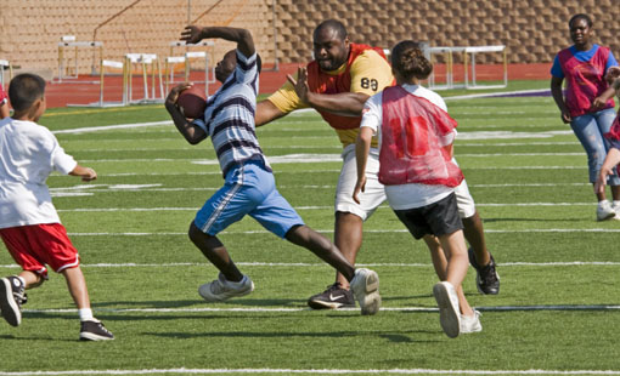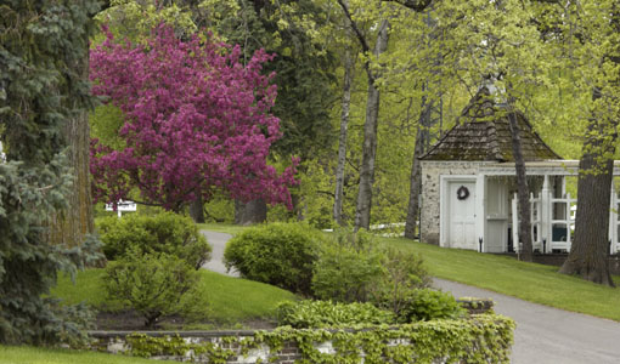Twelve-year-old Pedro Guttierez steps to the front of the Brady Educational Center classroom on St. Thomas' south campus, shy under the stares of the 15 or so contemporaries gathered in a semicircle of desks. His task is to impersonate a famous person from a list the class has compiled. Instructor Kelechi Jaavaid, a long, lean former college basketball player, actor and comedian who has filmed commercials with the likes of NBA megastar Kevin Garnett, lets his legs dangle as he leans back on a classroom table and observes.
"Mike, try and figure out who Pedro is," Jaavaid tells another student as Guttierez begins his actions. With his soft brown eyes moving toward the floor, Guttierez, dressed in camouflage shorts and a T-shirt, spreads his arms wide, swooshing back and forth cautiously, like an airplane unsure of its wings.
"I know it!" one classmate shouts. "Yeah. Man, that's an easy one."
Mike, the other student, stays silent, shuffling his feet and watching Guttierez, who continues his tenuous flight.
"That's it, use distinctive movements," Jaavaid tells him. "Give Mike something to go on."
"Hey - can I make a sound?" Guttierez asks, his face brightening, and Jaavaid says to go ahead.
"Whoosh, whoosh, whoosh," he says, waving his arms as he swoops around the classroom, forgetting his shyness for a few moments.
"Oh, I got it," Mike says. "Superman!"
The class erupts in applause, and Guttierez cracks a shy smile, learning how to spread his wings and fly. He is like many of the 2,500 National Youth Sports Program kids who spent four or five weeks for each of the past 16 summers on the St. Thomas campus. Among the many well-known alumni are NFL star Larry Fitzgerald Jr.; Raymond Brown, who played in the NCAA basketball tournament for Bradley University; NFL player Dominique Byrd, who attended the University of Southern California; and NBA player Alan Anderson from Michigan State.
But federal budget cuts could mean NYSP, a national program that started almost 40 years ago and has helped more than 2 million at-risk kids stay out of trouble while learning sports and life skills, might become permanently grounded starting in 2007.
"It looks pretty bleak for next year," says St. Thomas' Mark Ahrens, who has been running the program at St. Thomas for the past 15 years. "In talking with Senator Norm Coleman's office and others, I don't think that these programs are even on the radar screen. They are so worried about the war in Iraq and the deficit ... things like this don't even register anymore. The federal grant, before it was cut, was $18 million for NYSP.
"That $18 million ran 200-plus programs and served 75,000 to 80,000 kids around the nation each year. So I think the bang for the buck was pretty good. But these days, $18 million doesn't even register ... they don't even sense it or feel it. Senator Coleman and others have visited the program; they know about it. But I think their minds are on other things. They just don't sense this."
Ahrens said the NYSP national office has reorganized itself as the National Youth Sports Corp., a nonprofit aimed at raising funding from the NCAA, professional sports leagues and others to keep NYSP programs going in future years. But he says observers aren't optimistic that they'll have enough immediate success to secure the level of funding needed to keep NYSP going around the country.
Long legacy of success
It's hard not to sense the impact NYSP, aimed at helping youngsters ages 10 to 16, has had on kids such as Guttierez, the younger brother of St. Thomas track star and NCAA individual champion Kristal Grigsby (who will graduate this December with a double major in sociology and psychology).
"I really like it," Guttierez says, standing outside the classroom an hour later. While he talks, students around him are lining up for a shuttle run competition. "I've been coming for three summers now. The people are really nice. The sports are fun."
"It's really disappointing the federal government has cut NYSP funding," says Grigsby, 22, who spent three summers in the program. "This is a moderately priced program that needs to continue. Why cut an educational program that is needed for the next generation to succeed?"
St. Thomas' NYSP success stories range from professional athletes such as Fitzgerald, a former Minnesota Vikings ball boy and NFL star, to actors like Da'Ray Sherow, who performs at the Penumbra Theater in St. Paul and attends the University of Minnesota, to Melanie Larsen Sinouthasy, manager for special scholarships for Minnesota's private colleges.
"I remember Larry Fitzgerald was always tossing his football around when he'd come to camp as a kid," says Jaavaid, 43, who has been teaching kids drama and improv at NYSP for close to a decade. "Eventually one of our counselors had to take it away from him, and we teased him about it. And I still try to school these young boys on the basketball court when they come through, like Alan Anderson (now with the NBA's Charlotte Bobcats). Alan was a great athlete, sure, but he was also always trying to be funny in class. He really loved satire."
Jaavaid, who played Division II college basketball at Missouri Western State College and later in the NBA's Summer League, is exactly the kind of instructor Ahrens likes to showcase to the kids.
"What I like about someone like Kelechi is that he's able to show them more than one dimension to themselves," Ahrens says. "He played college basketball and played in the NBA's Summer League, so they see this guy who's athletic, and the kids think, 'Oh, OK, just another basketball player.' And Kelechi does coach some sports for me. But then they come in and do creative writing and poetry and improv, and they learn something different about the person."
"You're going to have to do some sports"
NYSP began in 1968 when the National Collegiate Athletic Association (NCAA) and the President's Council on Physical Fitness started the program at a pair of universities. In 1969, the White House announced the federal government was committing $3 million to help establish and maintain the sports-themed program for economically disadvantaged youth, according to NYSP's official Web site.
Ahrens, who arrived at St. Thomas in the summer of 1990 to teach quantitative methods and computer science, and mathematics, still does that. He was already involved in summer programs teaching kids math and science at the University of Minnesota, where he had been a graduate student. Dr. Robert Brown, who retired from St. Thomas' School of Education in 2005, started the first NYSP camp on the St. Thomas campus in 1991, and asked Ahrens to take over the program on a permanent basis that summer.
"He said to me, 'You know, if you want to serve more kids, there's this thing called NYSP,' " Ahrens recalls, strolling down Grand Avenue under a blazing summer sun. "I told him I was interested. And he said, 'The only bad thing is, you're going to have to do some sports.' And we found some people who could do sports, and we just kind of kept the educational pieces in place that we wanted to do. And St. Thomas really became a trendsetter in the sense that there were very few institutions running NYSP camps that were also doing anything with math, science or things like that, which is what we started out with in addition to the sports."
As Ahrens talks, a walkie-talkie strapped to his belt squawks as camp counselors talk to one another. Ahrens, a soft-spoken, easygoing sort, spends his days filling out paperwork and mingling among the different groups of kids his staff instructs on everything from soccer and football to creative writing and entrepreneurship. Preparing for NYSP and then running the camps consumes his schedule from April through November each year.
Funding is failing
Ahrens' biggest challenge these days is how to keep NYSP functioning beyond 2006.
"Actually, at St. Thomas we've been pretty lucky," he says. "Because a lot of institutions have to get by with just the federal money, but in our 16 years we've always been able to get something else. The Best Buy Children's Foundation has been huge for the last eight years."
With federal budget cuts all but eliminating his main funding source, Ahrens had to scramble to put the 2006 summer program together. He used $40,000 left over from a 2005 federal grant, $20,000 from the Best Buy foundation and $13,000 he had left from previous NYSP camps at St. Thomas, which provides facilities, office space and infrastructure for the camp.
Ahrens also cut a deal with the Minneapolis and St. Paul public school systems, both of which use St. Thomas as a summer school site.
"I got them to provide busing and four teachers from each district," Ahrens says, estimating that the busing alone saves him more than $1,200 a day. "The food service we get reimbursed from the Federal Department of Agriculture, because 90 percent of our kids come from low-income areas. So most of our kids qualify for free or reduced lunch. So that's how we've been managing."
Even with all his juggling, Ahrens said he still had to do plenty of trimming. Swimming lessons, for example, were cut because of the cost to hire four full-time instructors. This year, students took classes in communications, creative writing, drama, dance, entrepreneurship, football, bocce ball, golf, badminton, life skills, soccer, kickball, test prep, volleyball and business management. The typical day of activities was shortened to save costs.
And while NYSP usually gets more than 600 applications and can only take 350 or so each summer, Ahrens had to cut the number of attendees down to 222 children for 2006."I hate having to turn kids away, but the federal funding is basically gone," he says. "Over the years, it's been a special thing seeing these kids grow up. More than half of our staff is usually kids who came through the program and want to come back and help out. But I don't know what's going to happen for 2007."
Future stars, leaders
When asked what his favorite memories of the past 15 years are, Ahrens says it's seeing so many young kids coming into camp unsure of themselves and maturing right before his eyes.
"You look at a group, and you don't know who in that group is going to be a future leader. I tell the staff, 'The kids you have in your control, the kids you have in your classroom, you don't know which ones are going to become famous, or a leader of some sort, a politician, a doctor, a pro athlete. So have an impact on them and encourage them to chase their dreams.' "
An hour or so after he flew through that Brady classroom, Pedro Guttierez waits in line outside for his turn with the shuttle run activity. He smiles when asked about his performance as Superman. So does he see himself in the role of superhero again anytime soon?
"I don't know," Guttierez says, blushing. "But it was pretty interesting."





